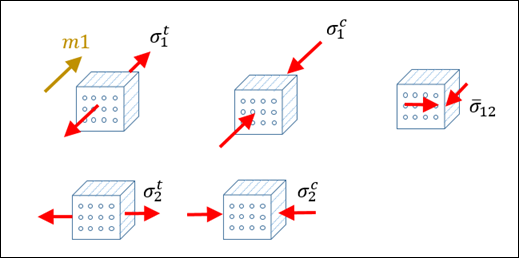/FAIL/PUCK
Block Format Keyword Describes the Puck failure model.
Format
| (1) | (2) | (3) | (4) | (5) | (6) | (7) | (8) | (9) | (10) |
|---|---|---|---|---|---|---|---|---|---|
| /FAIL/PUCK/mat_ID/unit_ID | |||||||||
| Ifail_sh | Ifail_so | ||||||||
| Fcut | |||||||||
| (1) | (2) | (3) | (4) | (5) | (6) | (7) | (8) | (9) | (10) |
|---|---|---|---|---|---|---|---|---|---|
| fail_ID |
Definition
| Field | Contents | SI Unit Example |
|---|---|---|
| mat_ID | Material identifier. (Integer, maximum 10 digits) |
|
| unit_ID | Unit Identifier. (Integer, maximum 10 digits) |
|
| Longitudinal tensile strength. Default = 1030 (Real) |
||
| Transverse tensile strength. Default = 1030 (Real) |
||
| Shear strength. Default = 1030 (Real) |
||
| Longitudinal compressive
strength. Default = 1030 (Real) |
||
| Transverse compressive
strength. Default = 1030 (Real) |
||
| Failure envelope factor 12
(+). Default = 0 (Real) |
||
| Failure envelope factor 12
(-). Default = 0 (Real) |
||
| Failure envelope factor 22
(-). Default = 0 (Real) |
||
| Dynamic time relaxation. 5 Default = 1030 (Real) |
||
| Ifail_sh | Shell failure model flag.
(Integer) |
|
| Ifail_so | Solid failure model flag.
(Integer) |
|
| Fcut | Stress tensor filtering
frequency. Default = 0.0 (Real) |
|
| fail_ID | Failure criteria
identifier. 4 (Integer, maximum 10 digits) |
Example (Composite)
Strength ( , , , , ) are taken from following tests. m1 is fiber direction.

#RADIOSS STARTER
#---1----|----2----|----3----|----4----|----5----|----6----|----7----|----8----|----9----|---10----|
/UNIT/1
unit for mat and failure
# MUNIT LUNIT TUNIT
g mm ms
#---1----|----2----|----3----|----4----|----5----|----6----|----7----|----8----|----9----|---10----|
#- 1. MATERIALS:
#---1----|----2----|----3----|----4----|----5----|----6----|----7----|----8----|----9----|---10----|
/MAT/COMPSH/1/1
composite example
# RHO_I
.0015
# E11 E22 NU12 Iform E33
114000 9650 .025 0 0
# G12 G23 G31 EPS_f1 EPS_f2
6000 6000 6000 0 0
# EPS_t1 EPS_m1 EPS_t2 EPS_m2 dmax
0 0 0 0 0
# Wpmax Wpref Ioff ratio
0 0 4 0
# b n fmax
0 0 0
# sig_1yt sig_2yt sig_1yc sig_2yc alpha
1E30 1E30 1E30 1E30 0
# sig_12yc sig_12yt c_12 Eps_rate_0 ICC
1E30 1E30 0 0 0
# GAMMA_ini GAMMA_max d3max
0 0 0
# Fsmooth Fcut
0 0
/FAIL/PUCK/1/1
# Sigma1_T Sigma2_T Sigma_12 Sigma1_C Sigma2_C
1720 55.2 103 765 503
# P+12 P-12 P-22 Tau_max Ifail_sh Ifail_so
0 0 0 .005 1 0
# Fcut
0.1
#---1----|----2----|----3----|----4----|----5----|----6----|----7----|----8----|----9----|---10----|
#enddata
#---1----|----2----|----3----|----4----|----5----|----6----|----7----|----8----|----9----|---10----|Comments
- This failure model is available for Shell and Solid.
- The failure mode criteria is written as:
- Fiber fraction failure:Tensile fiber failure mode:
(1) Compressive fiber failure mode:(2)
- Inter fiber failure:Mode A if :

Figure 1.(3) Mode C if :
Figure 2.(4) Mode B
Figure 3.
If the damage parameter is , the stresses are decreased by using an exponential function to avoid numerical instabilities. A relaxation technique is used by decreasing the stress gradually:(5) With,(6) and
Where,- Time
- Start time of relaxation when the damage criteria is assumed
- Time of dynamic relaxation
- Stress at the beginning of damage
- Fiber fraction failure:
- The damage value, D is
. The status for fracture is:
- Free, if
- Failure, if
With . This damage value shows with /ANIM/BRICK/DAMA or /ANIM/SHELL/DAMA.
- The fail_ID is used with /STATE/BRICK/FAIL and /INIBRI/FAIL. There is no default value. If the line is blank, no value will be output for failure model variables in the /INIBRI/FAIL (written in .sta file with /STATE/BRICK/FAIL option).
- After the failure criterion is reached, the value determines a period of time when the stress in the failed element is gradually reduced to zero. When the stress reaches 1% of stress value at the start of failure, the element is deleted. This is necessary to avoid instabilities coming from a sudden element deletion and a failure “chain reaction” in the neighboring elements. Even if the failure criterion is reached, the default value of results in no element deletion. Therefore, it is recommended to define 10 times larger than the simulation time step.
- To avoid a “chain reaction” when deleting elements, you can also
define a stress tensor filtering frequency Fcut.
Thus, the stress tensor used to calculate the PUCK criterion is first be filtered
according to the formula below:
(7) With(8) Where, is the current timestep.
If no filtering frequency is defined (Fcut = 0.0), the filtering effect is deactivated.